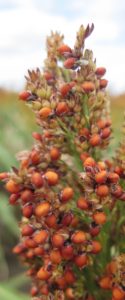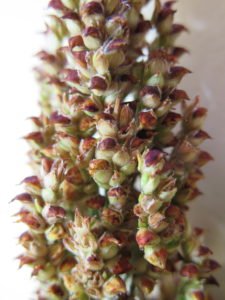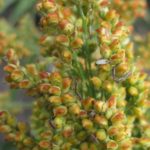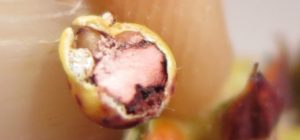Rutherglen bug (RGB) numbers are persisting in many sorghum crops as they start to reach physiological maturity. Queensland Department of Agriculture and Fisheries (DAF) research has shown no evidence of yield loss as a result of direct feeding on grain once it reaches physiological maturity (black layer). However, because most crops this year have staggered head emergence, there are a number of considerations to take into account in making a decision about whether further treatment of the crop to reduce RGB numbers is warranted.
RGB damage
RGB damage sorghum yield and quality by feeding directly on developing and filling grain. Not only does this reduce grain weight, but it allows entry of common fungi and bacteria that further deteriorates the grain. If infestations of RGB are present from flowering, feeding can prevent grain from filling. This very early damage looks very much like midge damage. Infestations that occur once grain is filling (milky-hard) will result in grain that is heavily spotted with feeding injury to the seed coat and lighter in weight.
Heat can also impact on sorghum heads causing darkened and pinched grain. This type of damage may be confused with RGB feeding damage. The presence of feeding spots on the seed is characteristic of RGB damaged grain.

Sorghum head that has not sustained RGB damage during early grain fill, but is now infested with adults; showing full grain and no spotting of seed

Sorghum head that has had sustained RGB feeding from early grain fill, showing characteristic spotting of the seed
Sampling
RGB are typically clumped in their distribution. Typically, when beating individual heads in a bucket, you will find heads with no, or very few RGB and others with hundreds. RGB release a chemical that results in aggregations of individuals.
When sampling it is useful to consider:
- The proportion of heads infested, and whether nymphs are present
- The age/maturity of infested heads
- The distribution of infestations
- are there earlier areas of the crop that are more heavily infested?
Infestations are typically initiated by movement of adults into the crop (often with winds associated with storms), so the youngest heads in the crop are at greatest risk of yield loss from prolonged RGB infestation.
Nymphs
RGB females lay eggs in the sorghum heads once they have fed on developing grain. RGB eggs and nymphs develop relatively slowly. Eggs take around 4-5 days to hatch and then the nymphs will take 2-3 weeks to develop from 1st instar to adult. This is why nymphs are generally only seen in maturing heads. Heavy infestations of nymphs will move up and down on the plant, feeding on both the leaves, stem and in the seed heads. Very small nymphs cannot damage seed, but larger nymphs (3rd-5th instar) can cause damage. Nymphs do not appear to move from plant to plant, so uninfested heads near heavily infested ones will not automatically be infested.
Threshold
If the crop has predominantly adults present, and infested heads are susceptible to damage, use the recommended economic threshold:
- Flowering to soft dough: 20 bugs per head
- Hard dough to physiological maturity to harvest: RGB have no impact on yield at these stages.
Large populations of adults and nymphs are usually seen in heads that are starting to colour, through to harvest.
Decisions about whether these later infestations warrant treatment should take into account:
- The stage of grain maturity (physiologically mature (i.e.black layer) seed is not at risk)
- Grain that is still soft dough:
- treat if adult numbers are over threshold
- if adult numbers are below threshold but nymph numbers above threshold, then treatment is warranted, but can be delayed if nymphs are small. This may allow time for the crop to reach physiological maturity.
- The potential for large populations to cause harvest and delivery issues (clogging, excess moisture, delivery of live insects).
Control options
Reinfestation by adults is common in RGB. Checking treated fields at 2-3 days after spraying will help in determining if the treatment was effective. Longer re-check intervals may be too long to distinguish between poor efficacy and reinfestation.
When RGB densities are extreme, it is challenging to get high levels of control. Keep in mind that 90% control of 400 RGB per head will still leave 40 RGB per head. Nymph populations can often be much higher than this.
The challenge of good control is exacerbated by large populations of nymphs that may be moving up and down the plant, and more difficult to contact directly with insecticide. For this reason, insecticides with some residual may be more effective against large, mobile populations of nymphs.



